Expert’s Rating
Pros
- Bright screen
- Slick operating system
- Great for tracking sports & workouts
Cons
- Works exclusively with iPhones
- Not as many fitness metrics as the competition
- Topographical maps cover US only
Our Verdict
With so few user-perceptible upgrades over the original, it isn’t worth upgrading to the Ultra 2. However, for everyone else, it’s a phenomenal smartwatch with very decent battery life.
Price When Reviewed
$799 (base)
Best Prices Today: Apple Watch Ultra 2
$749

$749

$799

$799

$799.99

$819
The Apple Watch Ultra is squarely aimed at adventurers: divers, hikers, and other athletes who need a rugged, long-lasting smartwatch that can cope with endurance events and extreme weather.
But in exactly the same way that people buy 4x4s with absolutely no intention of ever driving them off-road, the Ultra has also proven popular with ordinary folk that are never going to test its water resistance to a depth of 100m or rely on following waypoints out in the wilderness. They just love its looks and the fact it lasts twice as long between charges compared to a regular Apple Watch.
It has almost become a status symbol because of its high price, although not quite to the extent that the original Edition models did. The fact it’s so distinct from a Watch Series 7, 8, or 9 means it’s easy to stand out, unlike if you buy an iPhone 15; almost no one will know you have the latest model.
So the Apple Watch Ultra 2 is a great fashion accessory, but is it a good smartwatch? Fortunately, it is.
Design & display
- 49mm, 3000-nit OLED display
- Ambient light sensor
- 2nd-gen ultrawideband chip
If you’re unfamiliar with the Watch Ultra, it’s like a regular Apple Watch on steroids. It has a larger 49mm display, a bigger crown that’s easier to use while wearing gloves, and an extra button–the Action button–which can be customized to do various things, alongside activating the built-in 86-decibel siren.
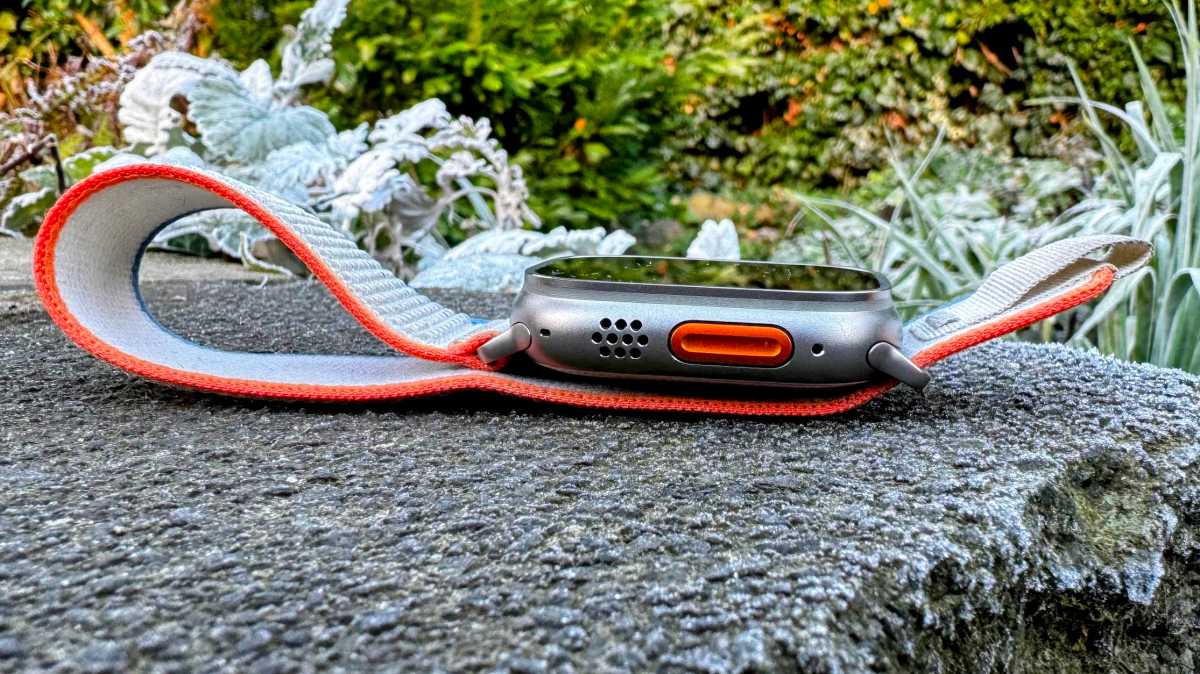
Jim Martin / Foundry
Instead of curved cover glass, which normal Apple Watches have, the Watch Ultra 2 has a flat sapphire crystal that’s offered a little extra protection by the metal case which sits just proud of it.
That case is made from 95 percent recycled titanium but isn’t offered in a choice of finishes like the iPhone 15 Pro. If you buy a Watch Ultra 2, it’s bare titanium or nothing. I’m sure the reason behind this is that it’s the most durable option when it gets scuffed or scratched as it won’t lose its color.
To help prevent accidental pressing of the crown and side button as well as to protect them, there’s a raised crown guard.
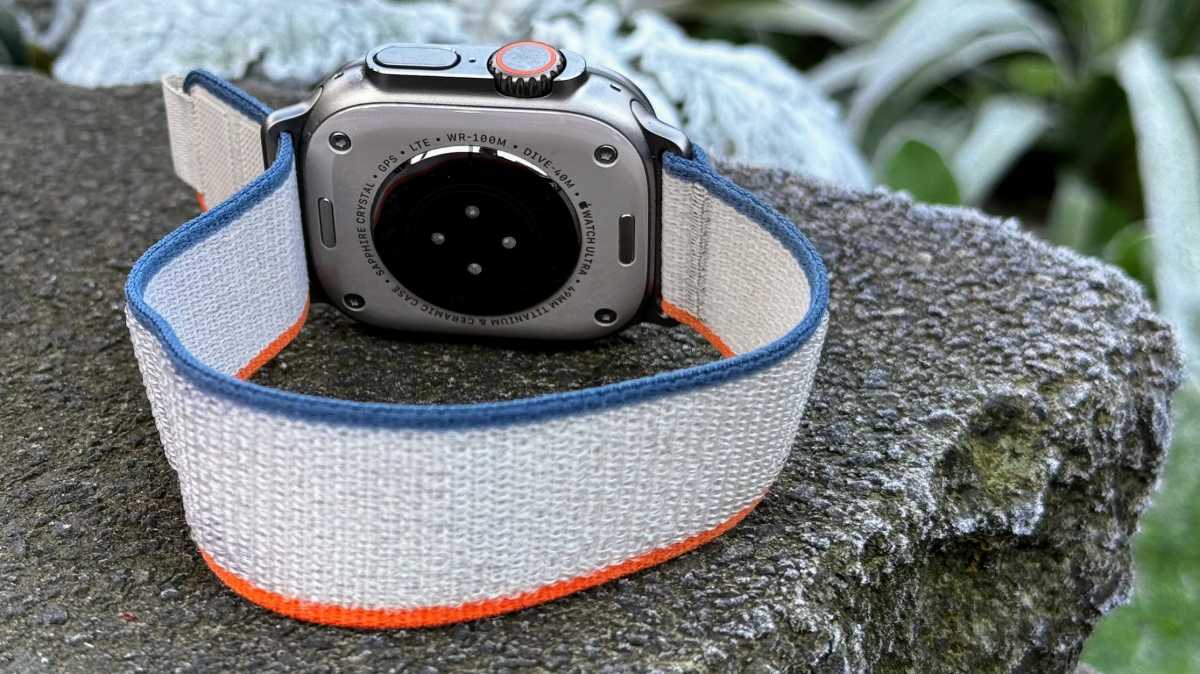
Jim Martin / Foundry
Without a strap, the Watch Ultra 2 weighs about 62g, around 10g more than the 45mm Watch Series 9. It’s over 14mm thick so doesn’t easily slip under shirt cuffs, but it’s not designed to do that and it’s generally just as comfortable to wear all day (and night) as a regular Apple Watch.
Three microphones help to reduce wind and other background noise so anyone you speak to on a call can hear what you’re saying. There’s also an ambient light sensor (an addition to the original Watch Ultra) that allows the display to switch to night mode automatically and it’s able to dim to just 1 nit, so it’s never dazzling at night.
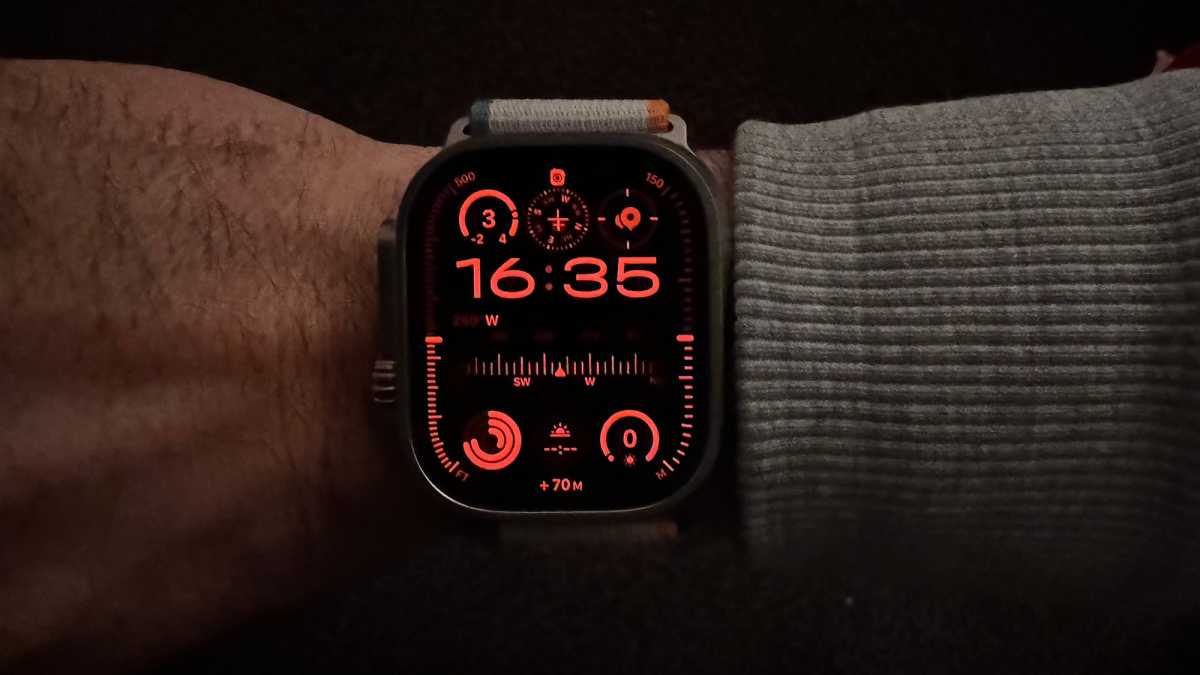
Jim Martin / Foundry
In terms of ruggedness, the Ultra 2 offers the same specs as the original Watch Ultra: IP6X water and dust resistance, which allows it to be taken as deep as 100m in water.
New is a 2nd-gen ultrawideband chip which makes it easier to find your lost iPhone. So long as that’s an iPhone 15 (or any other model with the same chip) you’ll see how far away it is as well as, crucially, in which direction to move towards it.
Another upgrade is brightness. The screen can now produce 3000 nits, which is phenomenally bright, but also arguably unnecessary when the Ultra’s 2000-nit display was already easy to read in direct sunlight. Where you’ll notice the difference is when you need a torch: you can turn the crown to temporarily ramp up to peak brightness.
It’s the size of the screen that makes the biggest difference if you’re coming from an older Apple Watch. It enables you to see much more information in one go, and the Ultra-specific watch faces are a great demonstration of that.

Jim Martin / Foundry
I’m a fan of the Modular face anyway, and Modular Ultra packs in seven complications and displays elevation in both feet and meters at the edges. There’s also Wayfinder which offers eight complications and is based around a traditional analog clock.
Although the Ultra 2 is compatible with 44mm and 45mm straps, Apple recommends you fit a 49mm strap for anything other than casual use. There are three styles: Alpine, Ocean, and Trail.
Apple sent the new orange/beige Trail band for this review, and it comes in two sizes: S/M and M/L. The small one fits wrists from 130-180mm, and the large 145-220mm. It’s stretchy, but I found it a bit of a challenge to get the S/M band over my hand, and I’m a small guy.

Apple
Both the Trail and Alpine Loop are carbon neutral, which is nice, and the Ocean band (above, right) is made from pliable silicone for diving and water sports.
Health & fitness tracking
- High and low heart rate notifications
- Irregular heart rhythm notification
- ECG app
- Sleep phases
Sitting behind the 49mm display is Apple’s latest S9 chipset. It’s exactly the same one used in the Watch Series 9 and along with the same set of sensors, it means the Ultra 2 does exactly the same health and fitness tracking.
Much of it is exactly what you’d expect from any fitness tracker: steps, distance, calories burned, flights climbed. That’s all packaged up in a slick system of ‘rings’ which lets you see at a glance how much progress you’ve made towards your daily move, exercise, and stand goals.
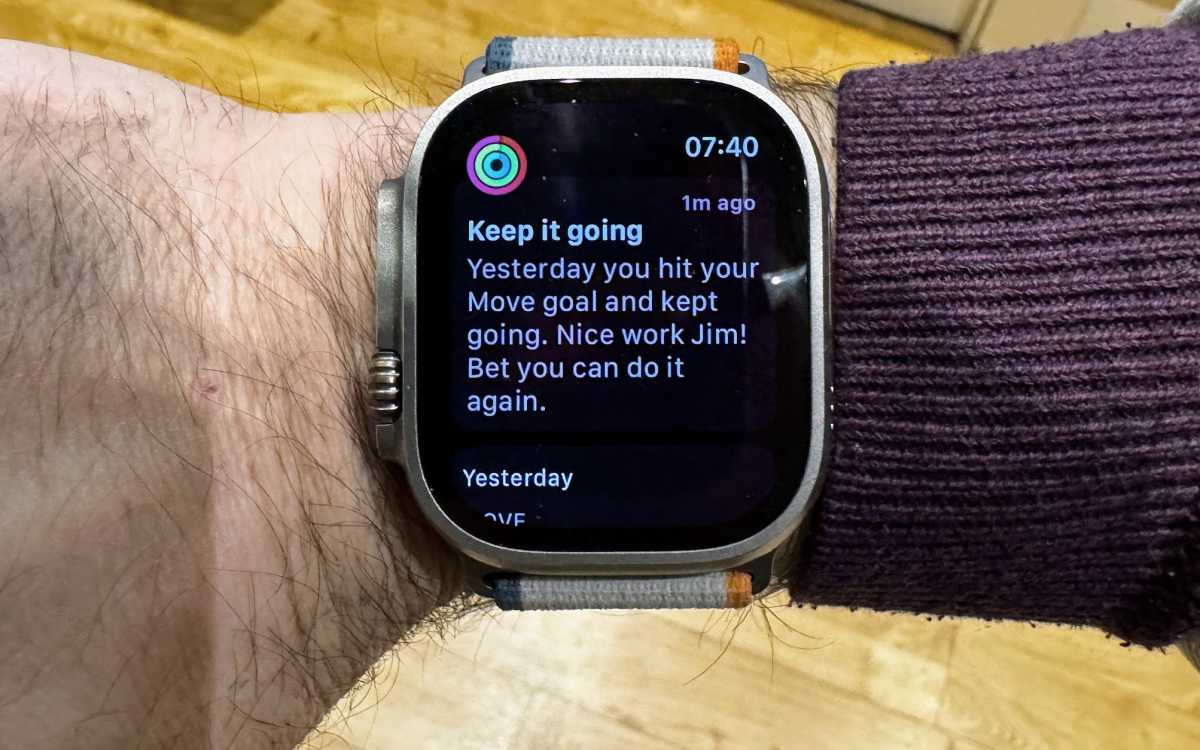
Jim Martin / Foundry
There’s loads more data available in the Health app on your phone from your physical effort in METs to the speed you walk up steps and your walking step length.
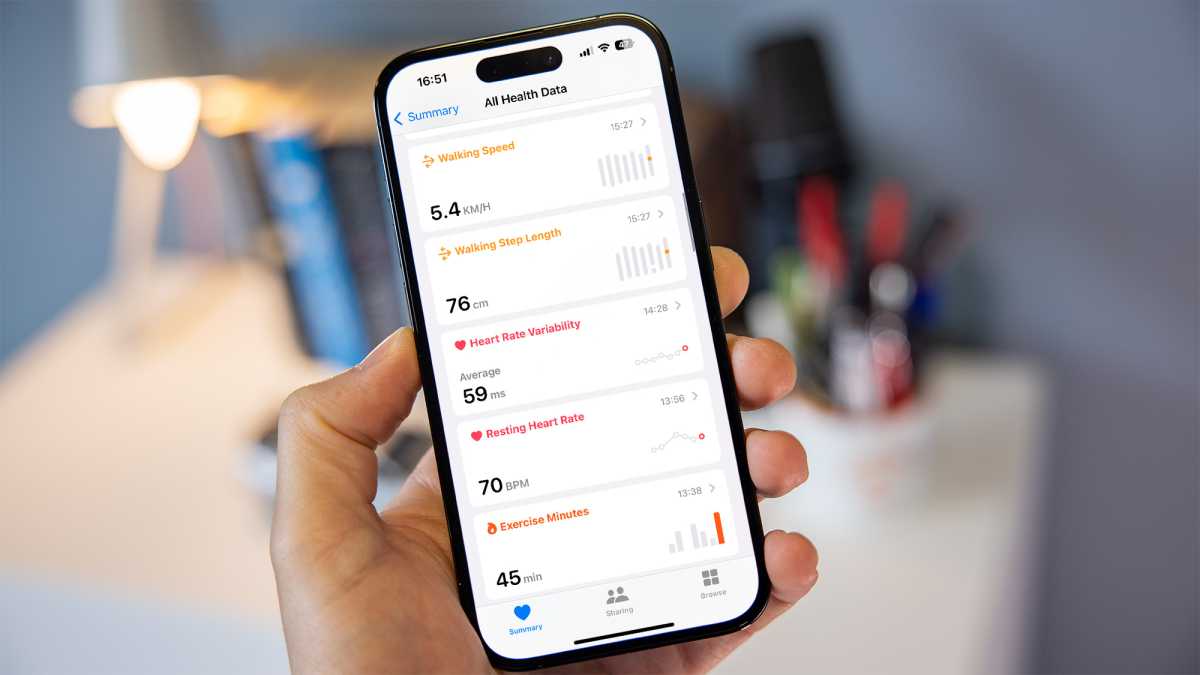
Dominik Tomaszewski / Foundry
Naturally, you can also track your activity when you exercise: it’s one of the Apple Watch’s strengths. Apple has broadened the variety of sports, and it’s possible to customize each one with the particular goals you want to achieve. And you can start a workout quickly by pressing the Action button if you’ve set it to do that.
It all works brilliantly, especially for running, walking and cycling. The only criticism, really, is that not every kind of workout records your route using the built-in GPS. So if you pick skiing, for example, you won’t be able to see where you went. Hopefully, this will be addressed over the next year or so.
For cyclists, there are a couple of new features including the ability to use your iPhone as a bike computer, mirroring the details from the Ultra to the larger screen. It’s also now possible to pair the Watch with Bluetooth accessories such as power meters, allowing you to get even more data in the Workouts app. These were added in watchOS 10, however, and aren’t exclusive to the Ultra 2.
I didn’t test it, but there’s a specific Depth app for divers that will display your live depth down to 40m, show the current water temperature, the maximum depth you’ve hit, and the length of time you’ve been under.
Hiking is a particular focus, just as it was on the original Ultra. Again, the Action button can be set to record waypoints, and when you press and hold it you can choose the Compass Backtrack option to retrace your steps, even if you don’t have a cellular signal, either to your phone or directly to the Ultra 2 itself.
The Compass app is a more useful tool these days with a variety of views that you can switch between by rotating the crown. Tapping the elevation readout toggles it between 2D and 3D views, showing any waypoints you’ve marked.
The system is designed for point-to-point hikes, though, so isn’t massively useful for circular routes.
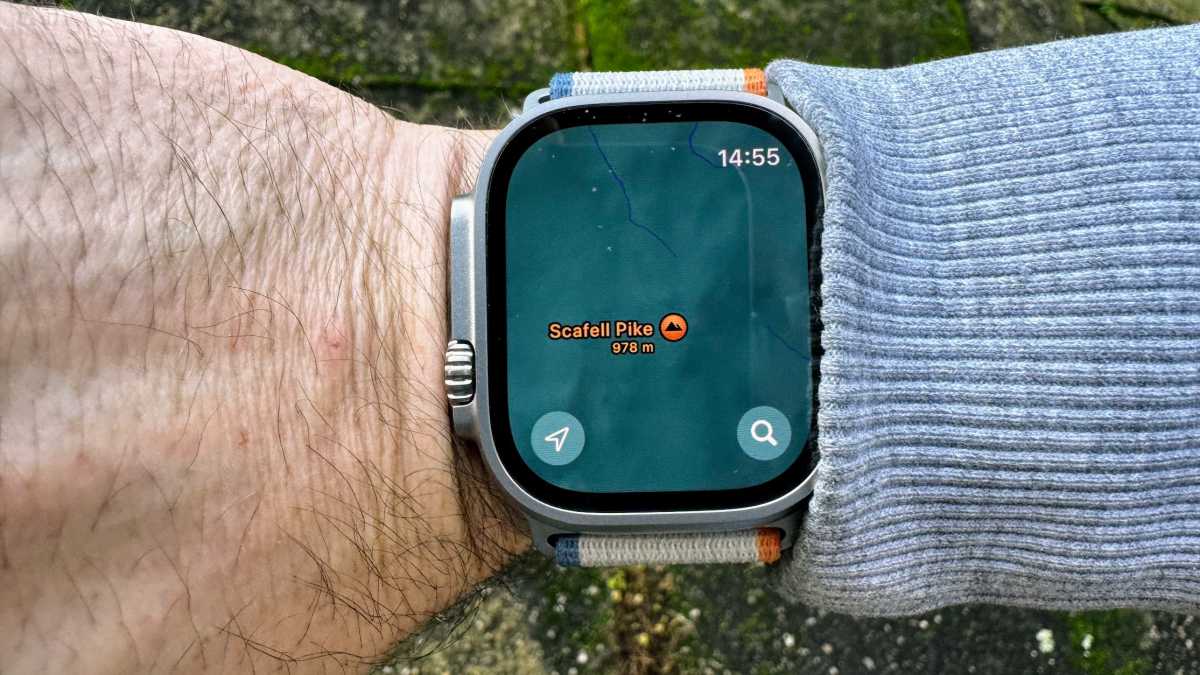
Jim Martin / Foundry
When hiking, you can now zoom in using the Maps app to see topographical information such as trails and contour lines as well as points of interest. These are available only in the U.S. at the moment so U.K. walkers in the Lake District, say, won’t see anything useful when climbing Scafell Pike, which is frustrating. Hopefully, it won’t be too long before these maps expand to cover the U.K. and other countries.
Strangely, given the Ultra 2’s 64GB of onboard storage, maps aren’t cached locally: They’re stored on your phone. This means there’s a bit of a delay when you move to a different area and start zooming in.
Another new feature is automatically detecting when you’re at a running track which will show a route map and let you select which lane you’re running in.
Beyond fitness and activity tracking, the Watch Ultra 2 can also monitor various aspects of your health from the quality of your sleep to your heart rate, and plenty more. Most of the measurements aren’t meant to be used for medical purposes, but the data is often very accurate, for heart rate in particular.
Just like the Series 9, the Ultra 2 can be set up to warn you if an irregular heart rhythm is detected, as well as unusually high or low heart rates. It can also detect a hard fall or severe car accident and, if set up and there’s a usable data connection, it will notify your emergency contacts and can automatically call emergency services if you don’t move or respond after the event.

Dominik Tomaszewski / Foundry
A skin temperature sensor monitors for changes and is primarily used for female cycle tracking. Anyone can see historical data (again in the Health app) but there’s not a lot we can do with it.
Yet another sensor can measure blood oxygen (for now), and you can take an ECG (which is also said to be very accurate by medical professionals).
Right now, it’s up to you to look at the data and do something with it: neither the Watch Ultra 2 nor the Health app attempt to interpret it and, say, warn you that you might be coming down with a virus, or even lifestyle changes you might want to make to be healthier.
Smart features & watchOS
As I said in my review of the Watch Series 9, watchOS 10 introduces some fairly radical changes. One is that rotating the crown upwards displays the new Smart Stack, a series of informational cards that you can customize.
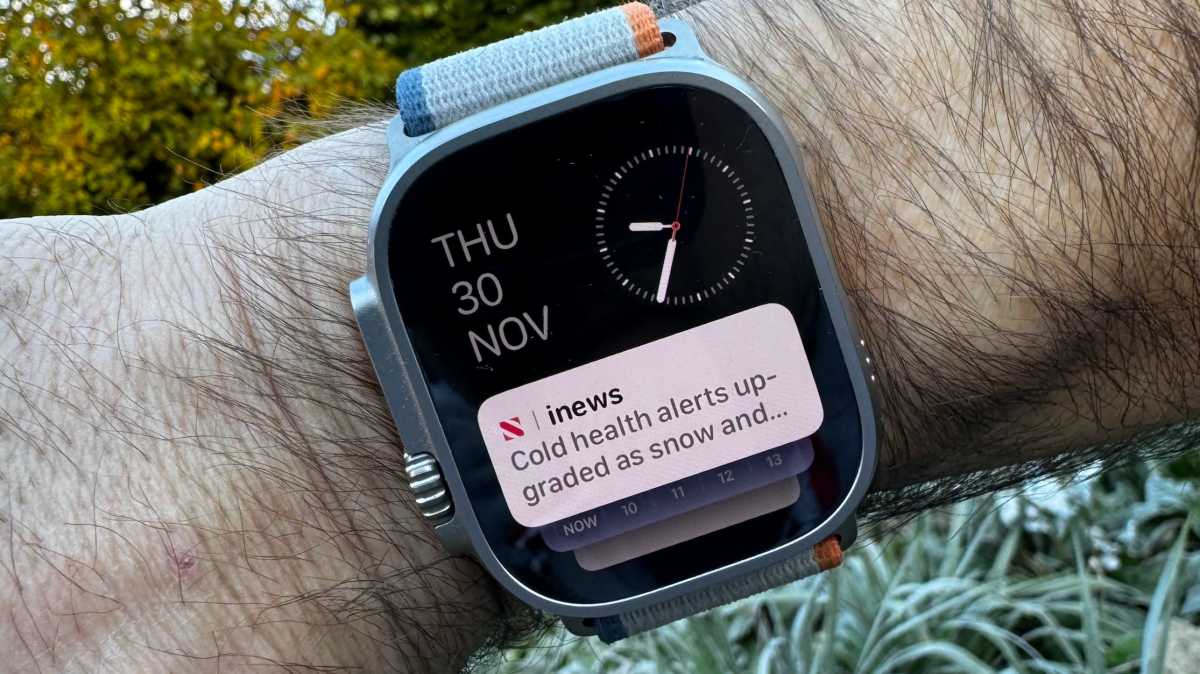
Jim Martin / Foundry
They’re things such as a weather forecast, next calendar event, news headlines, and activity data, but pretty much every default app has a card. You can advance through the cards using the digital crown, but it’s also possible to use Double Tap–one of the exclusive features of the Series 9 and Watch Ultra 2.
It is, admittedly, hard to understand the difference between this and the Double Pinch accessibility gesture that has been in watchOS for a few years now. Apple certainly hasn’t done a great job of explaining it, saying that the S9 chipset enables it. What it seems to mean by this is that Double Tap is ‘always on’ so you can use it at any moment.
The idea is that you don’t need your other hand to tap on the screen to answer a call, dismiss a timer or even start a workout when the Ultra 2 detects that’s what you’re doing. It’s certainly useful, but not a compelling enough reason to buy the Ultra 2 instead of the Ultra.
One of the big advantages Apple has over other smartwatch makers is that it makes both the iPhone and Watch, so they are the perfect companions for each other. You get rich notifications from apps, you can reply to messages, see directions for navigation, music playback controls, and much more.
It’s also a real disadvantage if you don’t own an iPhone because you can’t use the Watch Ultra 2 in even a limited way with an Android phone. To be clear, you can use an Apple Watch without any phone at all thanks to Family Setup, but someone in the family must have an iPhone for the initial setup, and that still doesn’t help much if you want it to work with an Android phone.
One feature the Ultra 2 holds–or will hold–over the original Ultra is the ability to process Siri commands without an internet connection thanks to the S9 chip’s neural engine. But let me clarify that: you can say only a small selection of things. Plus, any question or command that would require an internet connection won’t work.
This means you can get Siri to set timers, change settings, and call contacts. A data connection is needed for things like unit conversions, weather forecasts, and, well, everything else.
The neural engine also does a few other things such as speeding up Siri’s response time while the always-on mics mean there’s two seconds of buffering, so audio is captured before you raise your wrist which can also help speed up those responses.
Battery life
One of the main attractions of the Watch Ultra 2 (and its predecessor) is its battery life. Where the regular Watch lasts 18 hours, the Ultra 2 doubles that to 36 hours, then doubles it again in low-power mode.
If your mental arithmetic is anything like mine, it won’t be obvious that this means you can go a full three days between charges – longer than the 60 hours of low-power mode you get from the first Watch Ultra.
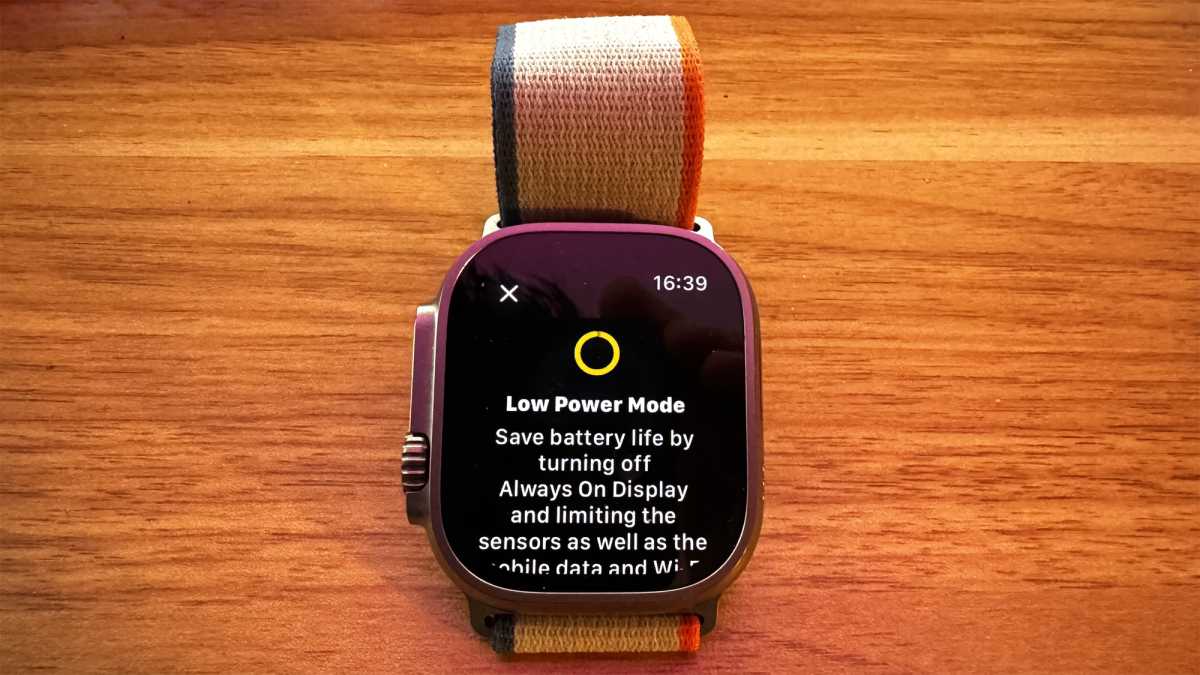
Jim Martin / Foundry
Importantly, low-power mode doesn’t remove any essential features: it’s eminently usable. It turns off the always-on display, doesn’t monitor heart rate and other things as frequently and limits mobile data and Wi-Fi so they’re not frivolously burning through the power reserves.
The good news is that those numbers are easily achievable, too. So long as you’re not hammering the battery by using the GPS for hours on end (about 17 hours is the maximum in that case) you can enjoy not having to pop the Ultra 2 on its charger every day.
I found that, on a normal working day with an hour-long workout that used the GPS to record a route, I’d end up with pretty much exactly 50% remaining by bedtime (having begun it with 100%). It then used about 5% overnight and told me to charge before bed the following evening.
Price & availability
The Watch Ultra 2 costs $799 / £799. That’s the same price as before in the U.S., but £50 less in the U.K.
The obvious place to buy one is directly from Apple, but small discounts can be found if you shop around.
There’s one price because, unlike the regular Apple Watch, every Ultra has built-in LTE. You can choose any of the three straps when buying an Ultra 2, and additional straps cost a faintly ridiculous $99 / £99. Third-party straps are widely available and much cheaper.
It’s a lot of money for a smartwatch, but it’s by no means the only expensive one. Garmin’s Fenix 7 Sapphire Solar (Amazon U.S./Amazon U.K.) is another rugged watch aimed at adventurers and costs around $800 / £700. The Solar Edition is so named because of its ability to recharge using sunlight. Another benefit is that it has pre-loaded TopoActive maps that cover the region in which it was bought. Plus, it’s compatible with Android as well as iPhone.
For more options, see Tech Advisor’s roundup of the best smartwatches.
Should you buy the Apple Watch Ultra 2?
If money is no object and you simply want the best Apple Watch, yes, buy an Ultra 2. However, with fairly significant discounts now available on the first-generation Ultra, a sensible move would be to buy one and save money.
You’ll miss out on auto-switching to night mode, but you’re unlikely to notice the other differences in day-to-day use, such as the extra screen brightness. The quad-core neural engine might be put to use in the future but, right now, it really isn’t doing a lot.
The extra half a day of battery life in low-power mode is an advantage, but not if you’re paying $200 / £200 more. Precision Finding is great too, but only if you have an up-to-date iPhone.
And if you don’t need the extra battery life and aren’t an adventurer, the Watch Series 9 has basically the same features for around half the price.
Ultimately, the Watch Ultra 2 is the best smartwatch Apple has made yet. It’s just not all that much better than the Ultra.



